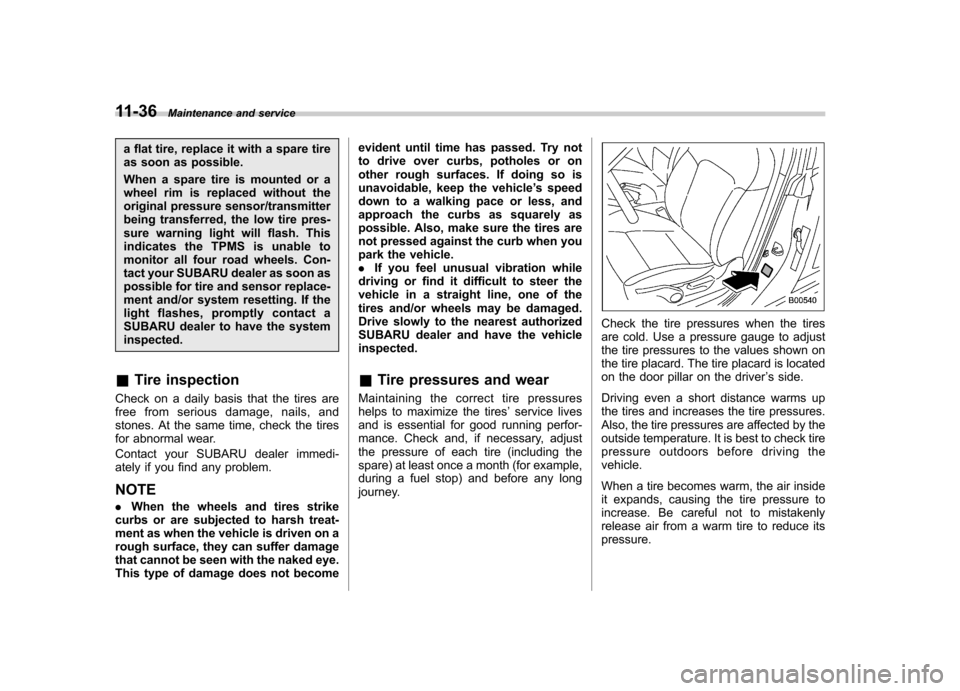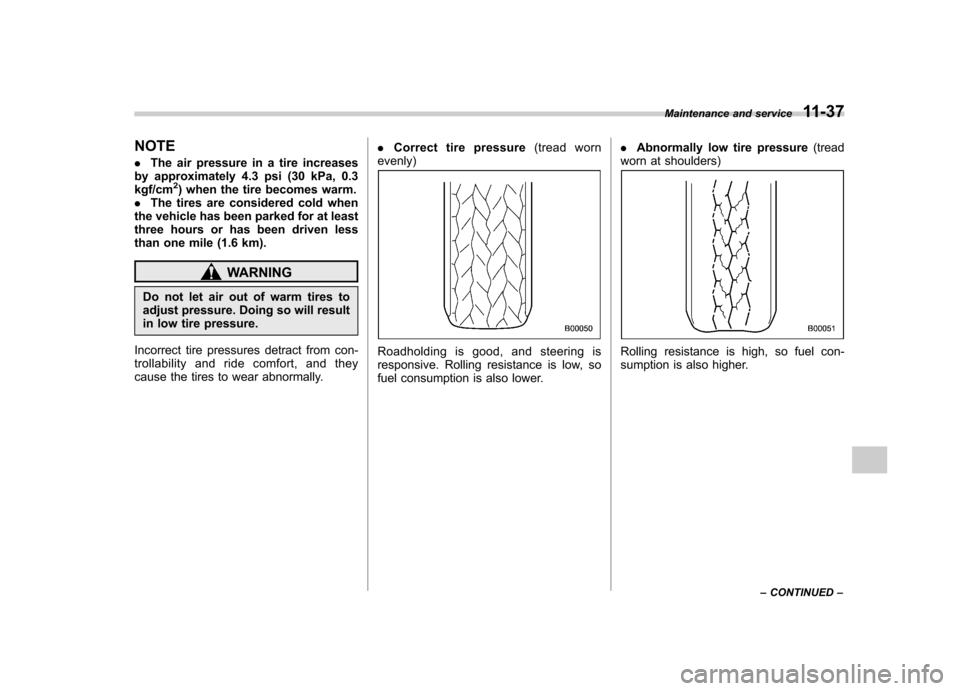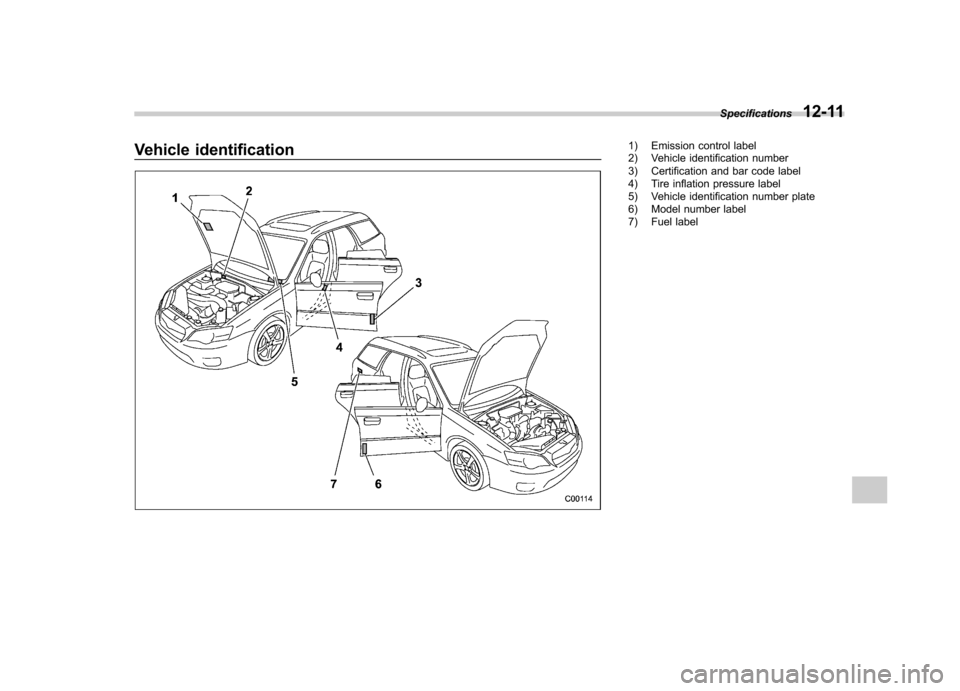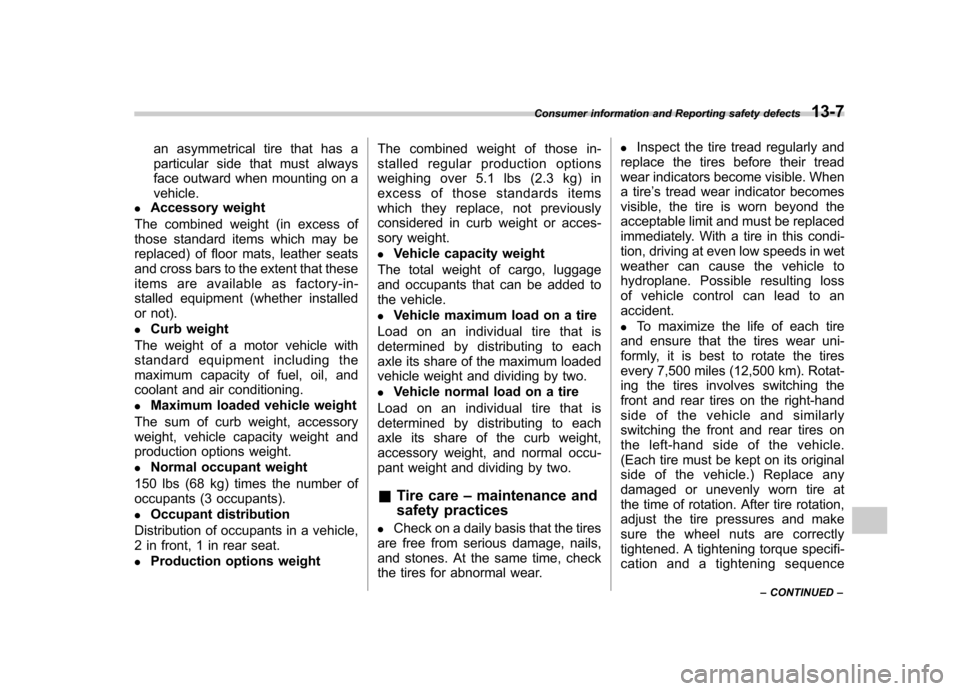2007 SUBARU OUTBACK fuel pressure
[x] Cancel search: fuel pressurePage 379 of 442

11-36Maintenance and service
a flat tire, replace it with a spare tire
as soon as possible.
When a spare tire is mounted or a
wheel rim is replaced without the
original pressure sensor/transmitter
being transferred, the low tire pres-
sure warning light will flash. This
indicates the TPMS is unable to
monitor all four road wheels. Con-
tact your SUBARU dealer as soon as
possible for tire and sensor replace-
ment and/or system resetting. If the
light flashes, promptly contact a
SUBARU dealer to have the systeminspected.
& Tire inspection
Check on a daily basis that the tires are
free from serious damage, nails, and
stones. At the same time, check the tires
for abnormal wear.
Contact your SUBARU dealer immedi-
ately if you find any problem. NOTE . When the wheels and tires strike
curbs or are subjected to harsh treat-
ment as when the vehicle is driven on a
rough surface, they can suffer damage
that cannot be seen with the naked eye.
This type of damage does not become evident until time has passed. Try not
to drive over curbs, potholes or on
other rough surfaces. If doing so is
unavoidable, keep the vehicle
’s speed
down to a walking pace or less, and
approach the curbs as squarely as
possible. Also, make sure the tires are
not pressed against the curb when you
park the vehicle.. If you feel unusual vibration while
driving or find it difficult to steer the
vehicle in a straight line, one of the
tires and/or wheels may be damaged.
Drive slowly to the nearest authorized
SUBARU dealer and have the vehicleinspected.
& Tire pressures and wear
Maintaining the correct tire pressures
helps to maximize the tires ’service lives
and is essential for good running perfor-
mance. Check and, if necessary, adjust
the pressure of each tire (including the
spare) at least once a month (for example,
during a fuel stop) and before any long
journey.
Check the tire pressures when the tires
are cold. Use a pressure gauge to adjust
the tire pressures to the values shown on
the tire placard. The tire placard is located
on the door pillar on the driver ’s side.
Driving even a short distance warms up
the tires and increases the tire pressures.
Also, the tire pressures are affected by the
outside temperature. It is best to check tire
pressure outdoors before driving thevehicle.
When a tire becomes warm, the air inside
it expands, causing the tire pressure to
increase. Be careful not to mistakenly
release air from a warm tire to reduce itspressure.
Page 380 of 442

NOTE .The air pressure in a tire increases
by approximately 4.3 psi (30 kPa, 0.3 kgf/cm
2) when the tire becomes warm.
. The tires are considered cold when
the vehicle has been parked for at least
three hours or has been driven less
than one mile (1.6 km).
WARNING
Do not let air out of warm tires to
adjust pressure. Doing so will result
in low tire pressure.
Incorrect tire pressures detract from con-
trollability and ride comfort, and they
cause the tires to wear abnormally. .
Correct tire pressure (tread worn
evenly)
Roadholding is good, and steering is
responsive. Rolling resistance is low, so
fuel consumption is also lower. .
Abnormally low tire pressure (tread
worn at shoulders)Rolling resistance is high, so fuel con-
sumption is also higher. Maintenance and service
11-37
– CONTINUED –
Page 414 of 442

Vehicle identification1) Emission control label
2) Vehicle identification number
3) Certification and bar code label
4) Tire inflation pressure label
5) Vehicle identification number plate
6) Model number label
7) Fuel labelSpecifications
12-11
Page 422 of 442

an asymmetrical tire that has a
particular side that must always
face outward when mounting on a
vehicle.
. Accessory weight
The combined weight (in excess of
those standard items which may be
replaced) of floor mats, leather seats
and cross bars to the extent that these
items are available as factory-in-
stalled equipment (whether installed
or not). . Curb weight
The weight of a motor vehicle with
standard equipment including the
maximum capacity of fuel, oil, and
coolant and air conditioning. . Maximum loaded vehicle weight
The sum of curb weight, accessory
weight, vehicle capacity weight and
production options weight. . Normal occupant weight
150 lbs (68 kg) times the number of
occupants (3 occupants). . Occupant distribution
Distribution of occupants in a vehicle,
2 in front, 1 in rear seat. . Production options weight The combined weight of those in-
stalled regular production options
weighing over 5.1 lbs (2.3 kg) in
excess of those standards items
which they replace, not previously
considered in curb weight or acces-
sory weight. .
Vehicle capacity weight
The total weight of cargo, luggage
and occupants that can be added to
the vehicle. . Vehicle maximum load on a tire
Load on an individual tire that is
determined by distributing to each
axle its share of the maximum loaded
vehicle weight and dividing by two. . Vehicle normal load on a tire
Load on an individual tire that is
determined by distributing to each
axle its share of the curb weight,
accessory weight, and normal occu-
pant weight and dividing by two. & Tire care –maintenance and
safety practices
. Check on a daily basis that the tires
are free from serious damage, nails,
and stones. At the same time, check
the tires for abnormal wear. .
Inspect the tire tread regularly and
replace the tires before their tread
wear indicators become visible. When
a tire ’s tread wear indicator becomes
visible, the tire is worn beyond the
acceptable limit and must be replaced
immediately. With a tire in this condi-
tion, driving at even low speeds in wet
weather can cause the vehicle to
hydroplane. Possible resulting loss
of vehicle control can lead to an
accident. . To maximize the life of each tire
and ensure that the tires wear uni-
formly, it is best to rotate the tires
every 7,500 miles (12,500 km). Rotat-
ing the tires involves switching the
front and rear tires on the right-hand
side of the vehicle and similarly
switching the front and rear tires on
the left-hand side of the vehicle.
(Each tire must be kept on its original
side of the vehicle.) Replace any
damaged or unevenly worn tire at
the time of rotation. After tire rotation,
adjust the tire pressures and make
sure the wheel nuts are correctly
tightened. A tightening torque specifi-
cation and a tightening sequence
Consumer information and Reporting safety defects
13-7
– CONTINUED –
Page 435 of 442

14-6Index
Low fuel warning light ................................... 3-7, 3-21, 3-29
LSD (Limited slip differential) ....................................... 7-33
Lumbar support ........................................................... 1-8
M
Main fuse ................................................................. 11-49
Maintenance Precautions ........................................................... 11-3
Schedule .............................................................. 11-3
Seatbelt ................................................................ 1-23
Tools .................................................................... 9-18
Manual Climate control system ............................................. 4-3
Mode ............................................................ 7-21, 7-27
Seat ....................................................................... 1-3
Transmission oil .................................................... 11-21
Transmission-5 speeds ........................................... 7-15
Transmission-6 speeds ........................................... 7-17
Map light ........................................................... 6-2, 11-57
Maximum load limits ................................................... 8-22
Meters and gauges .............................................. 3-5, 3-18
Mirrors ...................................................................... 3-48
Moonroof .................................................................. 2-26
Multi-information display ................................................ 3-8
N
New vehicle break-in driving .......................................... 8-2
O Odometer .................................................................. 3-19
Odometer/Tripmeter ..................................................... 3-9 Off road driving
........................................................... 8-6
Oil filter ................................................................... 11-10
Oil level
Engine .................................................................. 11-9
Front differential gear (AT vehicles) ... ...................... 11-24
Manual transmission ............................................. 11-21
Rear differential .................................................... 11-25
Oil pressure warning light ............................................ 3-26
Outside mirrors .......................................................... 3-50
Outside temperature indicator ...................................... 3-35
Overhead console ....................................................... 6-7
Overheating engine .................................................... 9-12
PParking Brake stroke ........................................................ 11-33
Light switch ........................................................... 3-42
Parking your vehicle ................................................... 7-44
Periodic inspections ..................................................... 8-4
Power
Door locking switches .............................................. 2-7
Seat ....................................................................... 1-4
Steering ................................................................ 7-33
Steering fluid ........................................................ 11-28
Windows ............................................................... 2-20
Precautions against vehicle modification ................ 1-27, 1-64
Preparing to drive ........................................................ 7-9
Printed antenna ........................................................... 5-2
Page 438 of 442

Hitches................................................................. 8-25
Towing .................................................................. 8-21
Towing tips ............................................................ 8-27
Trip meter ................................................................. 3-19
Trunk lid ................................................................... 2-22
Release handle ..................................................... 2-23
Trunk light ................................................................ 11-58
Turn signal Indicator lights ....................................................... 3-33
Lever .................................................................... 3-41
U
Under-floor storage compartment ................................. 6-16
V
Valet mode ................................................................ 2-17
Vanity mirror ................................................................ 6-4
Vehicle Capacity weight ..................................................... 8-14
Identification ......................................................... 12-11
Symbols .................................................................... 3
Vehicle Dynamics Control OFF indicator light .................................................. 3-30
OFF switch ........................................................... 7-42
Operation indicator light .......................................... 3-30
System ................................................................. 7-38
Warning light ......................................................... 3-30
Ventilator .................................................................... 4-2
W
Warning and indicator lights ........................................ 3-22 Warning lights
ABS...................................................................... 3-28
All-Wheel Drive ...................................................... 3-30
Anti-lock Brake System ........................................... 3-28
AT OIL TEMPerature ............................................... 3-26
Brake system ......................................................... 3-28
Charge .................................................................. 3-26
CHECK ENGINE .................................................... 3-25
Door open ............................................................. 3-29
Low fuel ................................................. 3-7, 3-21, 3-29
Oil pressure ........................................................... 3-26
Seatbelt. ................................................................ 3-22
SRS airbag system ................................................. 3-24
Vehicle Dynamics Control ................................ 3-30, 7-40
Warranties ..................................................................... 1
Warranties and maintenance ........................................ 8-21
Washing .................................................................... 10-2
Waxing and polishing .................................................. 10-3
Wear indicators ........................................................ 11-38
Wheel Alignment .............................................................. 12-5
Balance ............................................................... 11-38
Replacement. ....................................................... 11-40
Windows ................................................................... 2-20
Windshield Washer fluid. ........................................................ 11-41
Wiper and washer switches ..................................... 3-44
Wiper blades ........................................................ 11-43
Wiper deicer .......................................................... 3-46
Winter driving .............................................................. 8-8
Wiper and washer ...................................................... 3-43 Index
14-9